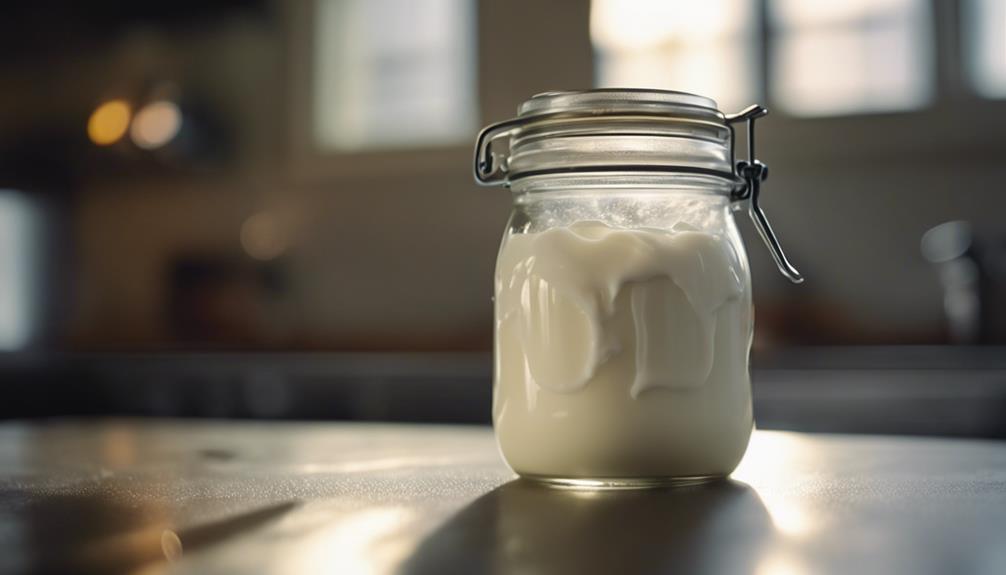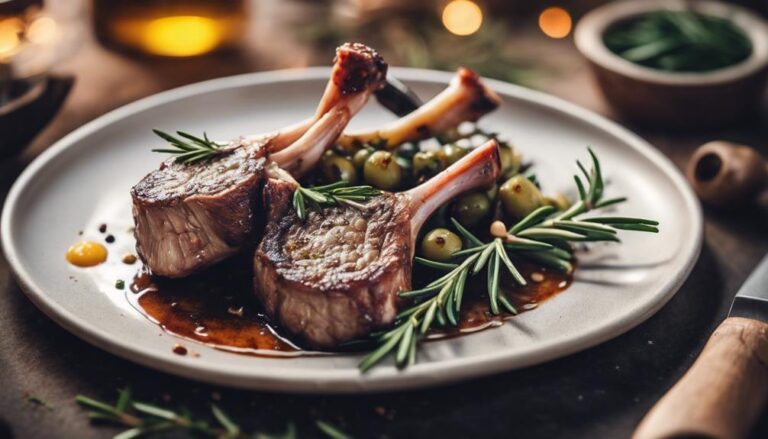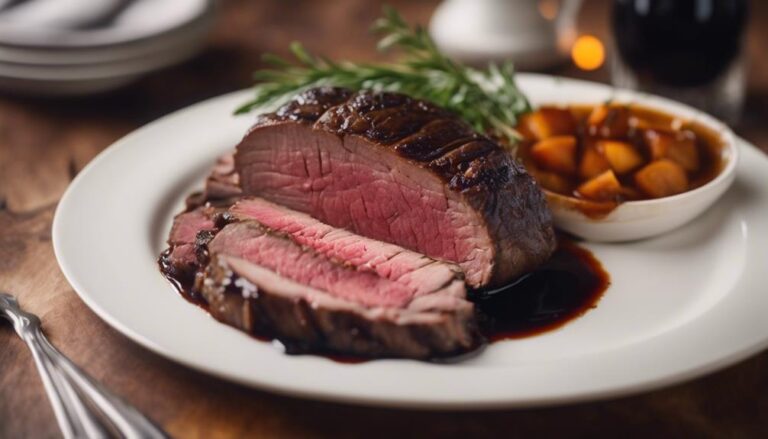Sous Vide Yogurt: Cultured and Creamy
For a velvety-smooth, tangy yogurt with a cultured richness, sous vide technology is key. Choose Lactobacillus bulgaricus for flavor, whole milk or cream for luxury. Control fermentation times for perfect tanginess and thick post-fermentation straining. Enhance sweetness with honey or maple syrup. Yet, there's still more to discover about enhancing yogurts' richness and texture.
What You Will Learn Here
- Utilize L. Reuteri for health benefits and tangy flavor.
- Achieve creaminess with whole milk or cream selection.
- Control fermentation for optimal texture and richness.
- Experiment with different cultures for varied creaminess.
- Enhance sweetness with natural additives like honey or maple syrup.
Yogurt's Ancient Origins
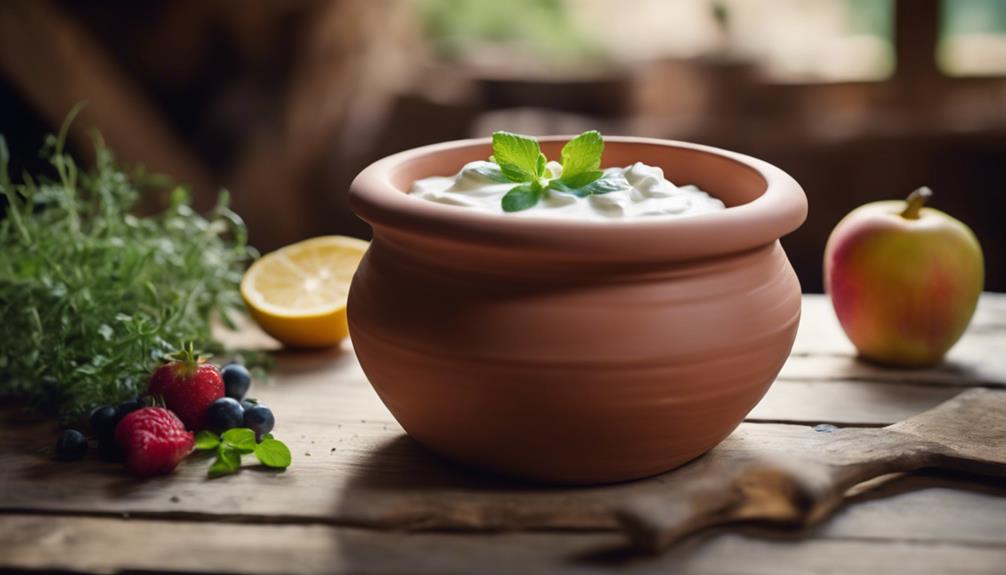
Yogurt's ancient origins trace back to 5000 BC in Mesopotamia, where the practice of fermenting milk began.
The word 'yogurt,' originating from Turkish, denotes the process of thickening or curdling.
Traditional yogurt making involved fermenting milk in animal skins or clay pots, showcasing the cultural significance of this dairy product.
Yogurt's Historical Roots
In the ancient world, the consumption of coagulated milk products traced back to 5000 BC in Mesopotamia. Yogurt, derived from the Turkish word meaning 'to be curdled or coagulated,' has a rich historical background. Ancient Greeks valued yogurt for its perceived health benefits, believing it to promote longevity and strength.
Traditionally, yogurt was made by fermenting milk with natural bacteria cultures, a practice that varied across cultures, showcasing yogurt's widespread popularity. The historical roots of yogurt highlight its significance as a nutritious food source that has stood the test of time.
When you make yogurt using sous vide, you can harness its historical origins while enjoying the modern benefits of precise temperature control for optimal fermentation.
Traditional Yogurt Making
Ancient civilizations such as the Mesopotamians and Egyptians pioneered the art of crafting yogurt through a meticulous process involving heating milk, introducing live cultures, and fermenting at specific temperatures. The technique of yogurt making has been passed down through generations, with variations in methods leading to a wide array of textures and flavors.
Traditional yogurt making typically begins by heating the milk to a specific temperature to kill off any harmful bacteria. Once the milk cools down, live yogurt cultures are added, kickstarting the fermentation process. This fermentation process is essential for the development of yogurt's distinct tangy flavor and creamy consistency.
The historical roots of yogurt making showcase the intricate balance of science and tradition in creating this beloved dairy product.
Cultural Significance of Yogurt
With origins dating back thousands of years, yogurt holds significant cultural importance due to its role in ancient civilizations like the Mesopotamians and Egyptians. The process of making yogurt involves fermenting milk with lactic acid bacteria, transforming it into a tangy and probiotic-rich food. The word 'yogurt' derives from Turkish, meaning 'to thicken' or 'to curdle,' reflecting the transformation milk undergoes during fermentation. This dairy product was valued not only for its extended shelf life but also for its digestive benefits, aiding in gut health. Different cultures worldwide have their unique variations of yogurt, showcasing its global culinary significance. Below is a table highlighting the cultural significance of yogurt in ancient civilizations:
| Civilization | Significance |
|---|---|
| Mesopotamians | Early yogurt consumers |
| Egyptians | Used yogurt for health |
Yogurt-Making Cultures and Bacteria
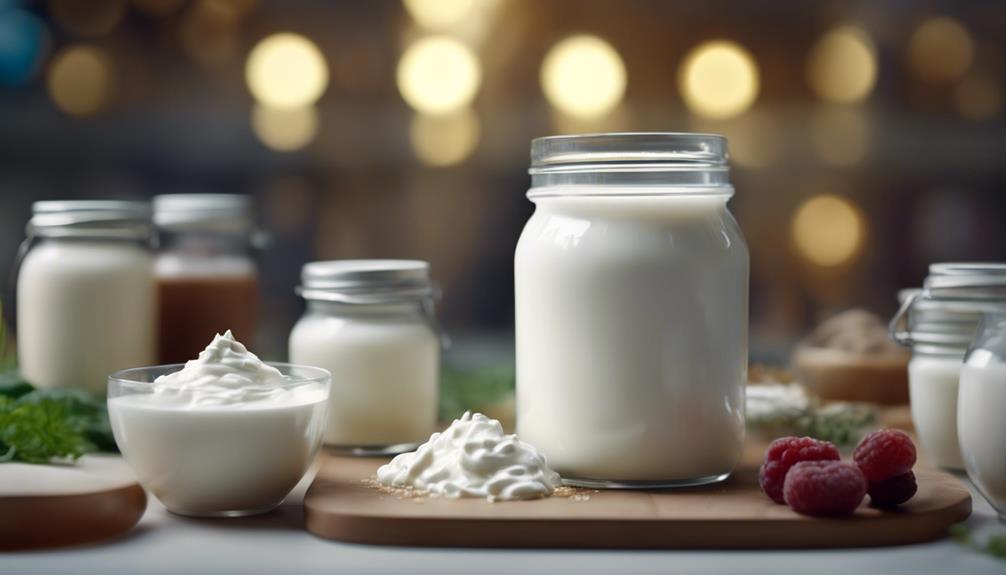
Utilizing specific yogurt-making cultures and bacteria is essential for achieving the desired flavor and texture in homemade yogurt. When it comes to creating delicious and beneficial yogurt, the selection of cultures plays an important role. Here are some key points to keep in mind:
- L. Reuteri and L. bulgaricus: These cultures are known for contributing to the distinct flavor and creamy texture of yogurt.
- Streptococcus thermophilus and Lactobacillus acidophilus: Common bacteria found in yogurt cultures that aid in the fermentation process by converting lactose into lactic acid.
- Probiotic strains: Including Bifidobacterium lactis and Lactobacillus casei in your yogurt can promote gut health when consumed regularly.
- Fermentation process: Understanding how specific cultures work together during the fermentation process is essential for achieving the desired results.
- Balancing flavors: Different cultures can impact the final taste of yogurt, so experimenting with combinations can help you find the perfect balance for your palate.
Tangy Yogurt Varieties
When aiming for tangy yogurt varieties, longer fermentation times are often utilized to enhance the acidic taste from increased lactic acid production.
Sweet toppings like honey or fruits can help balance out the tanginess of the yogurt.
The choice of starter cultures plays a significant role in determining the final tangy flavor profile of the yogurt product.
Sous Vide Yogurt Texture
To achieve a tangy yogurt variety with sous vide cooking, consider adjusting fermentation times for a more pronounced flavor profile. When aiming for a tangy yogurt variety, these tips can help you master the texture:
- Experiment with longer fermentation times for a more pronounced tanginess.
- Choose specific cultures like Lactobacillus bulgaricus for a tangier flavor.
- Opt for whole milk or cream for a richer and creamier texture.
- Strain the yogurt post-fermentation for a thicker consistency.
- Consider adding a touch of honey or maple syrup for a balanced tangy sweetness.
Sous Vide L. Reuteri Yogurt
For a tangy twist on your sous vide yogurt repertoire, explore the domain of L. Reuteri yogurt, known for its unique health benefits and distinctive fermentation process.
When making L. Reuteri yogurt using sous vide cooking, consider these key points:
- Using a yogurt maker guarantees precise temperature control throughout the fermentation process.
- Make yogurt with L. Reuteri bacteria starter culture for its specific health benefits.
- Maintain a consistent temperature of 105°F (40.5°C) for best fermentation.
- Reculture your L. Reuteri yogurt by reserving a portion from the previous batch to inoculate the next.
- Incorporate Prebio Plus to enhance the prebiotic content in your L. Reuteri yogurt for added health benefits.
L. Reuteri Sous Vide Yogurt
Efficiently produce tangy L. Reuteri yogurt varieties using the sous vide method to streamline large batch production and minimize cleanup efforts.
When making L. Reuteri yogurt, make sure to use ultra-pasteurized or heat regular whole milk to 195°F to denature proteins effectively.
The sous vide water bath maintains a consistent temperature for the fermentation process, aiding in the development of tangy flavors unique to L. Reuteri yogurt.
Reculturing L. Reuteri yogurt is achievable, allowing you to create subsequent batches of this beneficial superfood yogurt.
Remember, L. Reuteri yogurt offers health benefits such as treating SIBO, Candida, and boosting oxytocin levels.
Immerse yourself in the world of tangy goodness with L. Reuteri sous vide yogurt.
Yogurt Texture Enhancement
To enhance the texture of your yogurt, you can strain it through cheesecloth to thicken it by removing excess whey.
Adding gelatin before fermentation can improve the creaminess of the yogurt.
Opting for full-fat milk or cream can also contribute to a richer and smoother consistency.
Creaminess Factor in Yogurt
Enhancing the creaminess of yogurt involves strategic considerations such as milk fat content, culture selection, and fermentation time.
Greek yogurt, known for its thick and creamy texture, is achieved through straining to remove excess whey.
Another method to enhance creaminess is by adding thickening agents like powdered milk, gelatin, or pectin during the fermentation process.
By optimizing these factors, you can create a yogurt with a satisfying mouthfeel that can elevate a variety of dishes.
Experimenting with different techniques and ingredients, such as using an ice bath during the fermentation process, can help you tailor the creaminess of your homemade yogurt to suit your preferences.
Texture Improvement Techniques
Utilizing various textural enhancement methods can greatly enhance the overall quality of your homemade yogurt.
Straining the yogurt through cheesecloth helps remove excess whey, resulting in a thicker and creamier texture.
Adding gelatin to the yogurt mixture before fermentation can enhance firmness and silkiness.
Incorporating pectin, a natural thickening agent, during the yogurt-making process contributes to a smoother and more velvety texture.
Allowing the yogurt to ferment for up to 24 hours can lead to a denser and richer consistency.
Using higher fat content milk, like whole milk, improves creaminess and mouthfeel.
Consider using a water bath and cook method, mason jars, or an Anova sous vide for precise temperature control to achieve ideal texture in your yogurt.
Enhancing Yogurt's Richness
Strain your yogurt through cheesecloth or a coffee filter to enhance its thickness and creaminess. By removing excess water, you can achieve a richer texture.
To further enhance richness, consider heating and placing store-bought yogurt in a warm environment for longer fermentation times, which can develop a tangier flavor and creamier consistency. Additionally, incorporating heavy cream or full-fat milk can elevate the richness of homemade yogurt.
Experiment with thickening agents like gelatin to improve texture and mouthfeel. Varying yogurt cultures can also impact the final product's richness and creaminess.
These techniques offer a spectrum of options to tailor yogurt to your desired level of richness and creaminess.
Final Thoughts
In conclusion, mastering the process of creating L. Reuteri Superfood yogurt through sous vide offers a convenient and effective way to harness its unique health benefits. Making yogurt with the ability to control the fermentation process precisely is super easy when using a sous vide setup. The efficient batch production and minimal cleanup make it a practical choice for those looking to incorporate this specific probiotic strain into their diet. The health benefits associated with L. Reuteri yogurt, such as treating SIBO, Candida, and increasing oxytocin levels, make it a valuable addition to a wellness routine.
Additionally, the fermentation process for L. Reuteri Superfood yogurt differs from traditional methods, requiring specific equipment like a sous vide precision cooker, container, and thermometer for successful outcomes. Reculturing the yogurt for subsequent batches ensures a consistent and high-quality product each time. By following precise steps and maintaining the right conditions during fermentation, you can enjoy the creamy and cultured goodness of L. Reuteri Superfood yogurt in your daily diet.
Frequently Asked Questions
What Is the Best Temperature to Sous Vide Yogurt?
For the best results when sous vide cooking yogurt, aim for around 110°F or 43.3°C to guarantee ideal fermentation. Consistent temperature is key for cultures to thrive. Use precision cookers for control.
What Temperature Is Yogurt Cultured At?
Yogurt is cultured within a temperature range of 110°F to 115°F. This temperature facilitates the fermentation process where bacterial strains thrive, influencing yogurt texture. The duration is important for bacteria activity. Maintaining this range guarantees excellent yogurt quality.
Why Is My Homemade Yogurt Not Creamy?
If your homemade yogurt lacks creaminess, guarantee milk fat ratios for richness, employ straining techniques to remove whey, and choose a high-quality starter culture. Secure ideal fermentation conditions, avoiding overheating milk to prevent graininess.
Does Yogurt Get Thicker the Longer It Incubates?
Yes, yogurt gets thicker as it incubates longer. The longer incubation time allows for more fermentation, leading to increased lactic acid production, which contributes to a thicker consistency. Monitoring the process guarantees desired texture development.
Conclusion
Overall, sous vide yogurt offers a convenient and precise method for creating cultured and creamy yogurt at home. By controlling temperature and time, you can achieve consistent results with a variety of textures and flavors.
Experiment with different cultures and bacteria to customize your yogurt to your liking. With sous vide technology, you can enjoy tangy, velvety yogurt that's sure to impress your taste buds.
